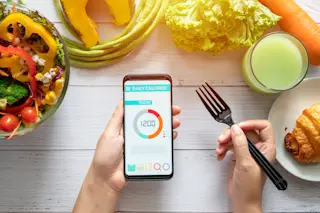The Science of Pie – June 1, 2014Best Overall Pie & People's Choice Pie Alina Naqvi & Ashley Lipkins-Scott (Team Apple Queens) This duo of student scientists aimed to create a pie with the crunchiest apple filling by experimenting with four different types of apples: Granny Smith, Red Delicious, Pink Lady, and Fuji. To determine which apples had the greatest resistance to applied forces (and thus remained crunchiest), they measured both the force required to cut through each kind of apple and the “elastic modulus”, which is the amount of deformation caused by a given force.
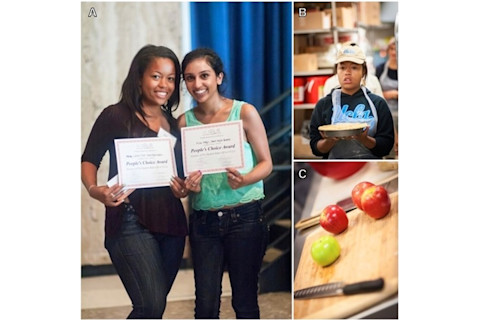
(A) Team Apple Queens receives the People's Choice Award at the 2014 Xcience of Pie event. (B) Lipkins-Scott carries the team's cinnamon crumb pie to the oven. (C) Fuji and Granny Smith apples were used for the Apple Queens's pie because the team found that these apple varieties had the highest values for elastic modulus. Photos courtesy of Patrick Tran. To measure the elastic modulus for each apple variety, the team applied a known weight to the apple slice and measured the deformation using a ruler before and after the apples were cooked. (See Panel A & B below). In addition, they wanted to see which apples had the most resistance (and thus, crunch) by measuring the force used to cut through the apples in a “Puncture Force” Test. For this test, the team added increasing volumes of water into a pot balanced over a knife to determine the mass of water required for the knife to cut through the apple slice. (See Panel C below).
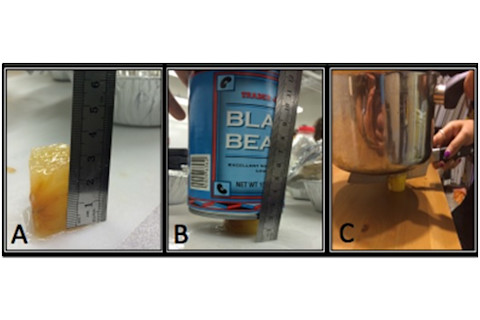
After the apples are baked, their lengths (A) and deformations (B) are measured to obtain the elastic modulus. (C) The Puncture Force Test measures the force required to cut through the cooked apples.

Before baking, the Fuji apple had the highest elastic modulus of 170,000 N/m^2 and the Pink Lady had the lowest elastic modulus of 130,000 N/m^2. After baking, the Granny Smith had the highest elastic modulus of 32,000 N/m^2 and the Fuji had the second highest elastic modulus at 28,000 N/m^2.

In the Puncture Force Test, the baked Granny Smith apple required the highest puncture force of 18N. Team Apple Queens found that the cooked Granny Smith apples exhibited the highest elastic modulus and also required the greatest force to cut through. Thus, the Granny Smiths were most resistant to external pressure and remained the crunchiest after baking. Having both the second highest elastic modulus and the second greatest puncture force were the Fuji apples. Based on these results, the team hypothesized that Granny Smith and Fuji apple varieties may contain more of the polysaccharide pectinto fortify their cell walls and make them harder, crunchier apples.
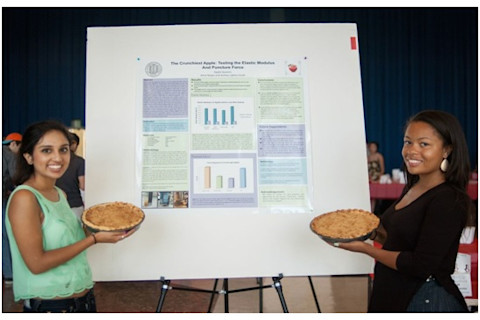
The students of Team Apple Queens stand proudly by their winning pie and poster. RecipeCrumbalicious Apple PieFor the crust: 1 1/3 cup all purpose flour 1⁄2 teaspoon salt 1⁄4 cup (1/2 stick) chilled unsalted butter, cut into 1⁄2-inch cubes 1⁄4 cup frozen solid vegetable shortening, cut into 1⁄2-inch cubes 3 tablespoons (or more) ice water 1⁄2 teaspoon apple cider vinegar For the filling: 3 Granny Smith apples, peeled, cored, and sliced 1⁄4 inch thick 1 Fuji apple, peeled, cored, and sliced 1⁄4 inch thick 2/3 cup cane sugar 2 tablespoons all purpose flour 2 teaspoons ground cinnamon 2 tablespoons unsalted butter, melted For the topping: 1 cup all purpose flour 1⁄2 cup cane sugar 1⁄4 cup brown sugar 1 and 1⁄2 teaspoons ground cinnamon 1⁄2 teaspoon salt 6 tablespoons chilled unsalted butter, cut into 1⁄2-inch cubes Position a rack in the center of the oven and preheat to 375°F. To prepare the crust: In a large bowl, mix flour, salt, and sugar. Add butter and shortening; rub in with fingertips until coarse meal forms. We want to incorporate flattened sheets of butter into the flour mixture to get a flaky crust. In a small bowl, mix three tablespoons of ice water and vinegar. Drizzle the water and vinegar solution over flour mixture. Stir with fork until moist clumps form, adding more water by teaspoonfuls if dough is dry. Gather dough into ball; flatten into disk. Wrap in plastic and refrigerate for at least 30 minutes. Refrigeration is important for allowing gluten strands to relax (so the dough becomes easier to roll out), and for letting letting liquids incorporate to moisturize the dough. Roll out dough on lightly floured surface to 12-inch round. (About 1/8^th 9-inch-diameter glass pie dish.) Trim overhang to 1/2 inch; turn edge under and crimp decoratively. Refrigerate while preparing filling and topping. To prepare the filling: Mix all ingredients in a large bowl to coat apples. To prepare the crumble topping: Blend all ingredients until mixture resembles wet sand. To assemble the pie: Toss the filling to redistribute juices and then transfer to crust, mounding in center. Pack topping over and around apples. Bake pie on baking sheet until topping is golden, about 1 hour (cover top with foil if browning happens too quickly). Cool until warm, about 1 hour. Recipe adapted from Bon Appétit: Cinnamon Crumble Apple Pie
Eunice Liu is studying Neuroscience and Linguistics at UCLA. She attributes her love of food science to an obsession with watching bread rise in the oven. Read more by Eunice Liu
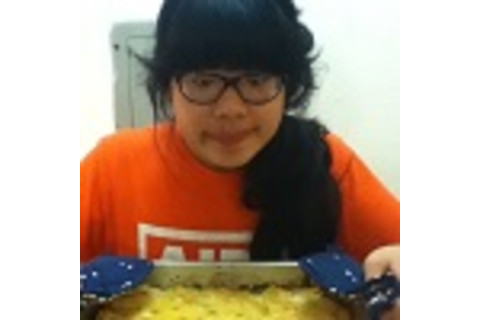
About the author:










